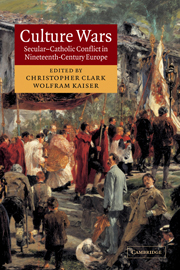Book contents
- Frontmatter
- Contents
- List of illustrations
- List of contributors
- Introduction: The European culture wars
- 1 The New Catholicism and the European culture wars
- 2 ‘Clericalism – that is our enemy!’: European anticlericalism and the culture wars
- 3 ‘Priest hits girl’: on the front line in the ‘war of the two Frances’
- 4 The battle for monasteries, cemeteries and schools: Belgium
- 5 Contested rituals and the battle for public space: the Netherlands
- 6 Nonconformity, clericalism and ‘Englishness’: the United Kingdom
- 7 The assault on the city of the Levites: Spain
- 8 Roma o morte: culture wars in Italy
- 9 Enemies at the gate: the Moabit Klostersturm and the Kulturkampf: Germany
- 10 Village quarrels and national controversies: Switzerland
- 11 The Counter-Reformation's last stand: Austria
- 12 The uncivil origins of civil marriage: Hungary
- Annotated bibliography
- Index
11 - The Counter-Reformation's last stand: Austria
Published online by Cambridge University Press: 23 July 2009
- Frontmatter
- Contents
- List of illustrations
- List of contributors
- Introduction: The European culture wars
- 1 The New Catholicism and the European culture wars
- 2 ‘Clericalism – that is our enemy!’: European anticlericalism and the culture wars
- 3 ‘Priest hits girl’: on the front line in the ‘war of the two Frances’
- 4 The battle for monasteries, cemeteries and schools: Belgium
- 5 Contested rituals and the battle for public space: the Netherlands
- 6 Nonconformity, clericalism and ‘Englishness’: the United Kingdom
- 7 The assault on the city of the Levites: Spain
- 8 Roma o morte: culture wars in Italy
- 9 Enemies at the gate: the Moabit Klostersturm and the Kulturkampf: Germany
- 10 Village quarrels and national controversies: Switzerland
- 11 The Counter-Reformation's last stand: Austria
- 12 The uncivil origins of civil marriage: Hungary
- Annotated bibliography
- Index
Summary
There are many memorable passages in Joseph Roth's The Radetzky March, but few are more evocative of imperial Austria than his description of the annual Corpus Christi procession, which celebrated the sacrament of the Host: ‘In black lacquered carriages sat the gold-decked Knights of the Golden Fleece and sober, apple-cheeked fathers. After them, like majestic hurricanes, fluttered the horsehair plumes of the infantry bodyguard. Finally, the bells of St Stephen's Cathedral pealed the welcome of the Roman Church to the…old Emperor.’ For Roth, looking back on the defunct Habsburg Monarchy from troubled inter-war central Europe, the display of majesty embodied a timeless feeling of stability and well-being, yet it was only comparatively recently that the Corpus Christi celebration had become the major state-patriotic display just described. Recent work by Daniel Unowsky reveals how the new emperor Francis Joseph sanctioned a revival of ‘traditional’ rituals as part of the restoration of monarchical authority after the 1848–9 revolutions. Alongside the foot-washing ceremony, when the emperor cleansed the feet of twelve paupers from the city of Vienna at Eastertide, the Corpus Christi celebration was transformed into a major event in the official calendar. In short, the Habsburg court recodified neglected practices in order to demonstrate publicly the restored, absolute power of the divinely ordained, Catholic ruler.
The highly visible reassertion of Francis Joseph's sovereignty provides a useful entry-point into the ‘culture wars era’, because it illustrates a major tension between two historical lines of state-building in Austria.
- Type
- Chapter
- Information
- Culture WarsSecular-Catholic Conflict in Nineteenth-Century Europe, pp. 285 - 312Publisher: Cambridge University PressPrint publication year: 2003
- 7
- Cited by

